Greco-Bactrian Kingdom
Kingdom of Bactria Βασιλεία τῆς Βακτριανῆς Basileía tēs Baktrianēs | |||||||||||||
|---|---|---|---|---|---|---|---|---|---|---|---|---|---|
| 256 BC–c. 120 BC | |||||||||||||
Eucratides Iwearing the Bactrian version of theBoeotian helmet,shown on his gold 20-stater, the largest gold coin ever minted in the ancient world, c. 2nd century BC.
| |||||||||||||
 | |||||||||||||
| Capital | Bactra Ai-Khanoum | ||||||||||||
| Common languages | Greek(official) Bactrian Sanskrit Aramaic Sogdian Parthian | ||||||||||||
| Religion | Ancient Greek religion
Greco-Buddhism Zoroastrianism | ||||||||||||
| Government | Hellenistic Monarchy | ||||||||||||
| Basileus | |||||||||||||
• 256–239 BC | Diodotus I(first) | ||||||||||||
• 117–100 BC | Heliocles I(last) | ||||||||||||
| Historical era | Antiquity | ||||||||||||
• Established | 256 BC | ||||||||||||
• Disestablished | c. 120 BC | ||||||||||||
| Area | |||||||||||||
| 184 BC[1] | 2,500,000 km2(970,000 sq mi) | ||||||||||||
| |||||||||||||
TheGreco-Bactrian Kingdom(Greek:Βασιλεία τῆς Βακτριανῆς,romanized:Basileía tēs Baktrianēs,lit. 'Kingdom of Bactria') was aGreekstate of theHellenistic period[2][3][4]located inCentral Asia.Along with theIndo-Greek Kingdomin theIndian subcontinent,it was the easternmost part of the Hellenistic world. The kingdom was foundedc. 256BC by theSeleucidsatrapDiodotus I Soterand lasted until its fallc. 120BC.[a]It was ruled by theDiodotid dynasty,Euthydemid dynasty,and the Eucratid dynasty.
The Greco-Bactrian Kingdom covered much of present-dayAfghanistan,Uzbekistan,Tajikistan,andTurkmenistan,and some parts ofKazakhstan,PakistanandIran.An extension further east, with military campaigns and settlements, may have reached the borders of theQin Statein 230 BC.[5][6]Its cities were among the largest and richest of antiquity; indeed, Bactria was known as the "land of a thousand cities."[7][8][9]
History[edit]
Origins[edit]
Bactriawas inhabited by Greek settlers since the time ofDarius I,when the entire population ofBarca,inCyrenaica,was deported to the region for refusing to surrender assassins.[10]Greek influence increased underXerxes I,after the descendants of Greek priests who had once lived nearDidyma(westernAsia Minor) were forcibly relocated in Bactria,[11]and later on with other exiled Greeks, most of them prisoners of war. Greeks communities and language were already common in the area by the time thatAlexander the Greatconquered Bactria in 328 BC.[12]
Independence and Diodotid dynasty[edit]
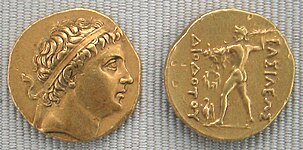
Diodotus, thesatrapof Bactria (and probably the surrounding provinces) founded the Greco-Bactrian Kingdom when he seceded from theSeleucid Empirearound 250 BC and becameBasileus,or kingDiodotus Iof Bactria. The preserved ancient sources (see below) are somewhat contradictory, and the exact date of Bactrian independence has not been settled. Somewhat simplified, there is a high chronology (c. 255BC) and a low chronology (c. 246 BC) for Diodotus' secession.[13]The high chronology has the advantage of explaining why the Seleucid kingAntiochus IIissued very few coins in Bactria, as Diodotus would have become independent there early in Antiochus' reign.[14][page needed]On the other hand, the low chronology, from the mid-240s BC, has the advantage of connecting the secession of Diodotus I with theThird Syrian War,a catastrophic conflict for the Seleucid Empire.
Diodotus, the governor of the thousand cities of Bactria (Latin:Theodotus, mille urbium Bactrianarum praefectus), defected and proclaimed himself king; all the other people of the Orient followed his example and seceded from the Macedonians.[15]
The new kingdom, highly urbanized and considered one of the richest of the Orient (opulentissimum illud mille urbium Bactrianum imperium"The extremely prosperous Bactrian empire of the thousand cities", according to the historianJustin[16]), was to further grow in power and engage in territorial expansion to the east and the west:
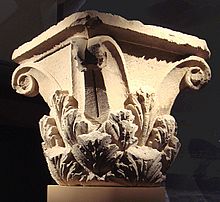
The Greeks who caused Bactria to revolt grew so powerful on account of the fertility of the country that they became masters, not only ofAriana,but also of India, asApollodorus of Artemitasays: and more tribes were subdued by them than by Alexander… Their cities wereBactra(also called Zariaspa, through which flows a river bearing the same name and emptying into theOxus), and Darapsa, and several others. Among these wasEucratidia,[17]which was named after its ruler.[18]
In 247 BC, thePtolemaic empire(the Greek rulers of Egypt following the death ofAlexander the Great) captured the Seleucid capital,Antioch.In the resulting power vacuum,Andragoras,the Seleucid satrap of Parthia, proclaimed independence from the Seleucids, declaring himself king. A decade later, he wasdefeated and killedbyArsacesof Parthia, leading to the rise of aParthian Empire.This cut Bactria off from contact with the Greek world. Overland trade continued at a reduced rate, while sea trade betweenGreek Egyptand Bactria developed.
Diodotus was succeeded by his sonDiodotus II,who allied himself with the ParthianArsacesin his fight againstSeleucus II:
Soon after, relieved by the death of Diodotus, Arsaces made peace and concluded an alliance with his son, also by the name of Diodotus; some time later he fought against Seleucos who came to punish the rebels, and he prevailed: the Parthians celebrated this day as the one that marked the beginning of their freedom.[19]
Euthydemid dynasty and Seleucid invasion[edit]

Euthydemus,an Ionian Greek fromMagnesiaaccording toPolybius,[20][21]and possibly satrap ofSogdiana,overthrew the dynasty of Diodotus II around 230–220 BC and started his own dynasty. Euthydemus's control extended to Sogdiana, going beyond the city ofAlexandria Eschatefounded by Alexander the Great inFerghana:[citation needed]
And they also held Sogdiana, situated above Bactriana towards the east between the Oxus River, which forms the boundary between the Bactrians and the Sogdians, and theIaxartesRiver. And the Iaxartes forms also the boundary between the Sogdians and the nomads.[22]
Euthydemus was attacked by the Seleucid rulerAntiochus IIIaround 210 BC. Although he commanded 10,000 horsemen, Euthydemus initially lost abattleon theArius[23]and had to retreat. He then successfullyresisted a three-year siegein the fortified city ofBactra,before Antiochus finally decided to recognize the new ruler, and to offer one of his daughters to Euthydemus's sonDemetriusaround 206 BC.[24]Classical accounts also relate that Euthydemus negotiated peace with Antiochus III by suggesting that he deserved credit for overthrowing the original rebel Diodotus and that he was protecting Central Asia from nomadic invasions thanks to his defensive efforts:
... for if he did not yield to this demand, neither of them would be safe: Seeing that great hordes of Nomads were close at hand, who were a danger to both; and that if they admitted them into the country, it would certainly be utterly barbarised.[21]
In an inscription found in theKuliabarea ofTajikistan,in eastern Greco-Bactria, and dated to 200–195 BC,[25]a Greek by the name of Heliodotos, dedicating a fire altar toHestia,mentions Euthydemus as the greatest of all kings, and his sonDemetrius Ias "Demetrios Kallinikos", meaning "Demetrius the Glorious Conqueror":[26][25]
| Translation (English) |
|
|---|---|
| Transcription (originalGreek script) |
|
| Inscription (Ancient Greek) |
 |
Following the departure of the Seleucid army, the Bactrian kingdom seems to have expanded. In the west, areas in north-easternIranmay have been absorbed, possibly as far as intoParthia,whose ruler had been defeated byAntiochus the Great.These territories possibly are identical with the Bactrian satrapies ofTapuriaandTraxiane.
Expansion into the Indian subcontinent (around 180 BC)[edit]
Demetrius,the son of Euthydemus, started an invasion of the subcontinent just before 180 BC, a few years after theMauryan empirehad been overthrown by theShunga dynasty.Historians differ on the motivations behind the invasion. Some historians suggest that the invasion of the subcontinent was intended to show their support for theMauryan empire,and to protect the Buddhist faith from the religious persecutions of theShungasas alleged by Buddhist scriptures (Tarn). Other historians have argued however that the accounts of these persecutions have been exaggerated (Thapar,Lamotte).
Demetrius may have been as far as the imperial capitalPataliputrain today's eastern India (todayPatna). However, these campaigns are typically attributed to Menander. The invasion was completed by 175 BC. This established in the northwestern Indian Subcontinent what is called theIndo-Greek Kingdom,which lasted for almost two centuries until around 10 AD. The Buddhist faith flourished under the Indo-Greek kings, foremost among themMenander I.It was also a period of great cultural syncretism, exemplified by the development ofGreco-Buddhism.
Eucratides the Great[edit]
Back in Bactria,Eucratides I,either a general of Demetrius or an ally of theSeleucids,managed to overthrow the Euthydemid dynasty and establish his own rule, the short-lived Eucratid dynasty,[29]around 170 BC, probably dethroningAntimachus IandAntimachus II.The Indian branch of the Euthydemids tried to strike back. An Indian king called Demetrius (very likelyDemetrius II) is said to have returned to Bactria with 60,000 men to oust the usurper, but he apparently was defeated and killed in the encounter:


Eucratides led many wars with great courage, and, while weakened by them, was put under siege by Demetrius, king of the Indians. He made numerous sorties, and managed to vanquish 60,000 enemies with 300 soldiers, and thus liberated after four months, he put India under his rule.[31]
Eucratides campaigned extensively in present-day northwestern India, and ruled a vast territory, as indicated by his minting of coins in many Indian mints, possibly as far as theJhelum RiverinPunjab.In the end, however, he was repulsed by the Indo-Greek kingMenander I,who managed to create a huge unified territory.
In a rather confused account,Justinexplains that Eucratides was killed on the field by "his son and joint king", who would be his own son, eitherEucratides IIorHeliocles I(although there are speculations that it could have been his enemy's sonDemetrius II). The son drove over Eucratides' bloodied body with his chariot and left him dismembered without a sepulcher:
As Eucratides returned from India, he was killed on the way back by his son, whom he had associated to his rule, and who, without hiding his parricide, as if he didn't kill a father but an enemy, ran with his chariot over the blood of his father, and ordered the corpse to be left without a sepulture.[31]
Defeats by Parthia[edit]
During or after his Indian campaigns, Eucratides was attacked and defeated by theParthiankingMithridates I,possibly in alliance with partisans of the Euthydemids:

The Bactrians, involved in various wars, lost not only their rule but also their freedom, as, exhausted by their wars against the Sogdians, the Arachotes, the Dranges, the Arians and the Indians, they were finally crushed, as if drawn of all their blood, by an enemy weaker than them, the Parthians.[31]
Following his victory, Mithridates I gained Bactria's territory west of theArius,the regions ofTapuriaandTraxiane:"The satrapy Turiva and that of Aspionus were taken away from Eucratides by the Parthians."[22]
In the year 141 BC, the Greco-Bactrians seem to have entered in an alliance with the Seleucid kingDemetrius IIto fight again against Parthia:
The people of the Orient welcomed his (Demetrius II's) arrival, partly because of the cruelty of the Arsacid king of the Parthians, partly because, used to the rule of the Macedonians, they disliked the arrogance of this new people. Thus, Demetrius, supported by the Persians, Elymes and Bactrians, routed the Parthians in numerous battles. At the end, deceived by a false peace treaty, he was taken prisoner.[32]
The 5th century historianOrosiusreports that Mithridates I managed to occupy territory between theIndusand theHydaspestowards the end of his reign (c. 138BC, before his kingdom was weakened by his death in 136 BC).[b]
Heliocles Iended up ruling what territory remained. The defeat, both in the west and the east, may have left Bactria very weakened and open to nomadic invasions.
Nomadic invasions and fall[edit]
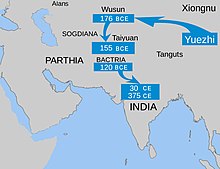
A nomadic steppe people called theYuezhiinhabited a region thousands of miles to the east of Bactria on the edges of theHan Empirecalled theHexi Corridor.Shortly before 176 BC, theXiongnuinvaded the Hexi Corridor, forcing the Yuezhi to flee the region. In 162 BC the Yuezhi were driven west to theIli Rivervalley by the Xiongnu. In 132 they were driven out of the Ili valley by theWusun.The surviving Yuezhi migrated again south towards the territory just north of the Oxus River where they encountered and expelled a nomadic steppe nation calledSakastan.[33]

Around 140 BC, easternScythians(theSaka,or Sacaraucae of Greek sources), apparently being pushed forward by the southward migration of theYuezhistarted to invade various parts of Parthia and Bactria. Their invasion of Parthia is well documented: they attacked in the direction of the cities ofMerv,HecatompolisandEcbatana.They managed to defeat and kill the Parthian kingPhraates II,son of Mithridates I, routing the Greek mercenary troops under his command (troops he had acquired during his victory overAntiochus VII). Again in 123 BC, Phraates's successor, his uncleArtabanus I,was killed by the Scythians.[34]
When theHan ChinesediplomatZhang Qianvisited the Yuezhi in 126 BC, trying to obtain their alliance to fight theXiongnu,he explained that the Yuezhi were settled north of theOxusbut also held under their sway the territory south of Oxus, which makes up the remainder of Bactria.
According to Zhang Qian, the Yuezhi represented a considerable force of between 100,000 and 200,000 mounted archer warriors,[c]with customs identical to those of the Xiongnu, which would probably have easily defeated Greco-Bactrian forces (in 208 BC when the Greco-Bactrian kingEuthydemus Iconfronted the invasion of the Seleucid kingAntiochus III the Great,he commanded 10,000 horsemen).[23]Zhang Qian actually visited Bactria (namedDaxiainChinese) in 126 BC, and portrays a country which was totally demoralized and whose political system had vanished, although its urban infrastructure remained:
Daxia (Bactria) is located over 2,000lisouthwest of Dayuan, south of the Gui (Oxus) river. Its people cultivate the land and have cities and houses. Their customs are like those of Dayuan. It has no great ruler but only a number of petty chiefs ruling the various cities. The people are poor in the use of arms and afraid of battle, but they are clever at commerce. After the Great Yuezhi moved west and attacked Daxia, the entire country came under their sway. The population of the country is large, numbering some 1,000,000 or more persons. The capital is called the city of Lanshi (Bactra) and has a market where all sorts of goods are bought and sold. (Records of the Great HistorianbySima Qian,quoting Zhang Qian, trans. Burton Watson)
The Yuezhi further expanded southward into Bactria around 120 BC, apparently further pushed out by invasions from the northernWusun.It seems they also pushed Scythian tribes before them, which continued to India, where they came to be identified asIndo-Scythians.

This invasion of Bactria is also described in western Classical sources from the 1st century BC:
The best known tribes are those who deprived the Greeks of Bactriana, the Asii, Pasiani,Tochari,and Sacarauli, who came from the country on the other side of theJaxartes,opposite theSacaeandSogdiani.[36]
Around that time the kingHelioclesabandoned Bactria and moved his capital to theKabulvalley, from where he ruled his Indian holdings. Apparently there were two other Greco-Bactrian kings preceding Heliocles in the same region and from the same dynasty, named Eucratides II andPlato Epiphanes,the latter probably being a brother of Eucratides I. Since Heliocles left the Bactrian territory, he is technically the last Greco-Bactrian king, although several of his descendants, moving beyond the Hindu Kush, would form the western part of theIndo-Greek kingdom.The last of these "western" Indo-Greek kings,Hermaeus,would rule until around 70 BC, when the Yuezhi again invaded his territory in theParopamisadae(while the "eastern" Indo-Greek kings would continue to rule until around AD 10 in the area of thePunjab region).

Overall, theYuezhiremained in Bactria for more than a century. They became Hellenized to some degree, as suggested by their adoption of the Greek Alpha bet to write their later Iranian court language,[37][38]and by numerous remaining coins, minted in the style of the Greco-Bactrian kings, with the text in Greek.
There is evidence for the persistence of Greek populations in Bactria after the collapse of the Greco-Bactrian kingdom. For example, anobolof a previously unknown ruler called Antigonus has been found and it seems he ruled after the kingdom's collapse, as evidenced by the use of a lunate sigma and the lower art quality of the coin, perhaps dating from the end of the 1st century BC. Antigonus might have briefly won a battle against the Yuezhi or the Saka before he was overrun himself.[39]
Around 12 BC the Yuezhi then moved further to northern India where they established theKushan Empire.
Military forces[edit]

Before the Greek conquest, the armies of Bactria were overwhelmingly composed of cavalry and were well known as effective soldiers, making up large portions of theAchaemenidcavalry contingents. 2,000 Bactrian horsemen fought at theGranicusagainst Alexander and 9,000 at theBattle of Gaugamelaon the left flank of Darius' army.Herodotusalso mentions the widespread use of chariots among the Bactrians. After Alexander's conquest of Bactria, Bactrian cavalry units served in his army during theinvasion of Indiaand after the Indian campaign, Alexander enlarged his elitecompanion cavalryby adding Bactrians, Sogdians and other east Iranian cavalrymen.[40]BothAeschylus(The Persians, v. 318) andCurtiusmention that Bactria was able to field a force of 30,000 horse. Most of these horsemen were lightly armed, using bows and javelins before closing with sword and spear. Herodotus describes the Persian cavalry of Mardonius at theBattle of Plataea(which included Bactrians) as horse archers (hippotoxotai). Bactrian infantry is described by Herodotus as wearing caps in the Median style, short spears and reedScythianstyle bows.[citation needed]
Alexander andSeleucus Iboth settledMacedoniansand other Greeks in Bactria, and archeological finds in the region have also attested to a major Macedonian presence, as evidenced by the presence of symbols, style of coinage, and epigraphic names.[41][42]Greek garrisons in the satrapy of Bactria were housed in fortresses calledphrouriaand at major cities. Military colonists were settled in the countryside and were each given an allotment of land called akleros.These colonists numbered in the tens of thousands, and were trained in the fashion of theMacedonian army.A Greek army in Bactria during the anti-Macedonian revolt of 323 BC numbered 23,000.[40]
The army of the Greco-Bactrian kingdom was then a multi-ethnic force with Greek colonists making up large portions of the infantry as pike phalanxes, supported by light infantry units of local Bactrians and mercenary javelin-wieldingThureophoroi.[43]The cavalry arm was very large for a Hellenistic army and composed mostly of native Bactrian,Sogdianand otherIndo-Iranianlight horsemen. Polybius mentions 10,000 horse at theBattle of the Ariusriver in 208 BC. Greco-Bactrian armies also included units of heavily armoredcataphractsand small elite units ofcompanion cavalry.The third arm of the Greco-Bactrian army was the Indianwar elephants,which are depicted in some coins with a tower (thorakion) orhowdahhousing men armed with bows and javelins. This force grew as the Greco-Bactrian kingdom expanded into India and was widely depicted in Greco-Bactrian coinage. Other units in the Bactrian military included mercenaries or levies from various surrounding peoples such as theScythians,Dahae,Indians, andParthians.[citation needed]
Culture and contacts[edit]
Greek culture in Bactria[edit]

Greeks first began settling the region long before Alexander conquered it. ThePersianEmpire had a policy of exiling rebelling Greek communities to that region long before it fell to Greek conquest. Therefore, it had a considerable Greek community that was expanded upon after Macedonian conquest.
The Greco-Bactrians were known for their high level ofHellenisticsophistication, and kept regular contact with both theMediterraneanand neighbouring India. They were on friendly terms with India and exchanged ambassadors.
Their cities, such asAi-Khanoumin northeasternAfghanistan(probablyAlexandria on the Oxus), and Bactra (modernBalkh) where Hellenistic remains have been found, demonstrate a sophisticated Hellenistic urban culture. This site gives a snapshot of Greco-Bactrian culture around 145 BC, as the city was burnt to the ground around that date during nomadic invasions and never re-settled. Ai-Khanoum "has all the hallmarks of a Hellenistic city, with a Greektheater,gymnasiumand some Greek houses with colonnaded courtyards "(Boardman). Remains of ClassicalCorinthiancolumns were found in excavations of the site, as well as various sculptural fragments. In particular a huge foot fragment in excellent Hellenistic style was recovered, which is estimated to have belonged to a 5–6 meter tall statue.
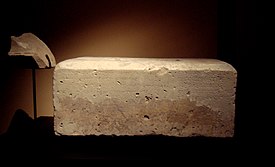
One of the inscriptions in Greek found at Ai-Khanoum, the Herôon of Kineas, has been dated to 300–250 BC, and describesDelphic maxims:
παῖς ὢν κόσμιος γίνου
ἡβῶν ἐγκρατής
μέσος δίκαιος
πρεσβύτης εὔβουλος
τελευτῶν ἄλυπος
As children, learn good manners.
As young men, learn to control the passions.
In middle age, be just.
In old age, give good advice.
Then die, without regret.
Several other Greco-Bactrian cities have been identified, for example a Bactrian document written on skin and dating to the rule of king Antimachus I mentions another city named Amphipolis which was clearly named after theAmphipolisin ancient Macedonia.[44]Excavated cities include Kampir Tepe in Uzbekistan, as well asSaksanokhurin southernTajikistan(archaeological searches by a Soviet team under B.A. Litvinski),[45]or inDal'verzin Tepe.
Some of the Greco-Bactrian coins, and those of their successors theIndo-Greeks,are considered the finest examples ofGreek numismatic artwith "a nice blend of realism and idealization", including the largest coins to be minted in the Hellenistic world: the largest gold coin was minted byEucratides(reigned 171–145 BC), the largest silver coin by the Indo-Greek kingAmyntas Nikator(reigned c. 95–90 BC). The portraits "show a degree of individuality never matched by the often bland depictions of their royal contemporaries further West" (Roger Ling, "Greece and the Hellenistic World" ).
-
BronzeHeraclesstatuette. Ai Khanoum. 2nd century BC.
-
Sculpture of an old man, possibly a philosopher. Ai Khanoum, 2nd century BC.
-
Close-up of the same statue.
-
Frieze of a naked man wearing achlamys.Ai Khanoum, 2nd century BC.
-
Gargoyle in the form of a Greek comic mask. Ai Khanoum, 2nd century BC.
-
Plate depictingCybelepulled by lions. Ai Khanoum.
-
Mosaic depicting theMacedonian sun,Ai Khanoum, 2nd century BC.
-
Bactrianphalerawith military elephant carrying ahowdahfortress manned by a soldier wearing aMacedonianhelmet. 2nd century BCE,Hermitage Museum.[46][47][48]
-
A Bactrian tax receipt written in Greek mentioning the Greco-Bactrian kingAntimachus I Theos,Eumenes and perhaps Antimachus II, 2nd century BC.
Takht-i Sangin[edit]
Takht-i Sangin (Tajik:"Throne of Stone" ) is an archaeological site located near the confluence of theVakhshandPanjrivers, the source of theAmu Darya,in southernTajikistan.During theHellenistic periodit was a city of the Greco-Bactrian kingdom with a large temple dedicated to theOxus(Vakhsh river), which remained in use in the followingKushanperiod, until the third century AD. The site may have been the source of theOxus Treasure.[49]
-
Ionic pillar, cella of the Temple of the Oxus, Takht-i Sangin, late 4th - early 3rd century BCE.[45]
-
Head of aGreco-Bactrianruler with diadem, Temple of the Oxus,Takht-i Sangin,3rd–2nd century BCE. This could also be a portrait ofSeleucus I.[50]
-
Hellenistic silenusMarsyasfrom Takhti Sangin, with dedication in Greek to the god of the Oxus, by "Atrosokes" (a Bactrian name). Temple of the Oxus, Takht-i Sangin, 200–150 BCE.Tajikistan National Museum.[45][51]
-
Alexander-Heracles head, Takht-i Sangin, Temple of the Oxus, 3rd century BCE.[45]
Contacts with Han China[edit]
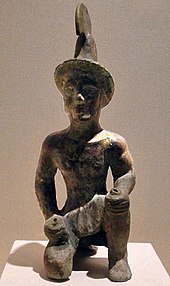
To the north, Euthydemus also ruledSogdianaandFerghana,and there are indications that fromAlexandria Eschatethe Greco-Bactrians may have led expeditions as far asKashgarandÜrümqiinXin gian g,leading to the first known contacts between China and the West around 220 BC. The Greek historianStrabotoo writes that: "they extended their empire even as far as theSeres(Chinese) and thePhryni".(Strabo,XI.XI.I).[18]
Several statuettes and representations of Greek soldiers have been found north of theTian Shan,on the doorstep to China, and are today on display in theXin gian gmuseum atÜrümqi(Boardman).[d]Middle Eastern or Greek influences on Chinese art have also been suggested (Hirth,Rostovtzeff). Designs withrosetteflowers, geometric lines,meandersand glass inlays, suggestive of Egyptian, Persian, and/or Hellenistic influences,[e]can be found on some earlyHan dynastybronze mirrors.[f]
Some speculate that Greek influence is found in the artworks of the burial site of China's first EmperorQin Shi Huang,dating back to the 3rd century BC, including in the manufacture of the famousTerracotta army.This idea suggested that Greek artists may have come to China at that time to train local artisans in making sculptures[55][56]However, this idea is disputed.[57]
Numismaticsalso suggest that some technology exchanges may have occurred on these occasions: the Greco-Bactrians were the first in the world to issuecupro-nickel(75:25 ratio) coins,[58]an alloy technology only known by the Chinese at the time under the name "White copper" (some weapons from theWarring States periodwere in copper-nickel alloy).[59]The practice of exporting Chinese metals, in particular iron, for trade is attested around that period. Kings Euthydemus, Euthydemus II,AgathoclesandPantaleonmade these coin issues around 170 BC. An alternative suggestion is that the metal in the coinage derived from a mine where a cupro-nickel alloy occurred naturally, perhapsAnarakin easternIran.[60]Copper-nickel would not be used again in coinage until the 19th century.
The presence of Chinese people in India from ancient times is also suggested by the accounts of the "Ciñas"in theMahabharataand theManu Smriti.TheHan dynastyexplorer and ambassadorZhang Qianvisited Bactria in 126 BC, and reported the presence of Chinese products in the Bactrian markets:
"When I was in Bactria (Daxia) ", Zhang Qian reported," I saw bamboo canes from Qiong and cloth made in the province of Shu (territories of southwestern China). When I asked the people how they had gotten such articles, they replied, "Our merchants go buy them in the markets of Shendu (India)." (Shiji123,Sima Qian,trans. Burton Watson).

The purpose of Zhang Qian's journey was to look for civilizations on the steppe that the Han could ally with against the Xiongnu. Upon his return, Zhang Qian informed the Chinese emperor HanWudiof the level of sophistication of the urban civilizations of Ferghana, Bactria and Parthia, who became interested in developing commercial relationships with them:
The Son of Heaven on hearing all this reasoned thus:Ferghana(Dayuan) and the possessions ofBactria(Daxia) andParthia(Anxi) are large countries, full of rare things, with a population living in fixed abodes and given to occupations somewhat identical with those of the Chinese people, and placing great value on the rich produce of China. (Hanshu,Former Han History).
A number of Chinese envoys were then sent to Central Asia, triggering the development of theSilk Roadfrom the end of the 2nd century BC.[61]
Contacts with the Indian subcontinent (250–180 BC)[edit]
The Indian emperorChandragupta,founder of theMauryan dynasty,conquered the northwestern subcontinent upon the death ofAlexander the Greataround 323 BC. However, contacts were kept with his Greek neighbours in theSeleucid Empire,a dynastic alliance or the recognition of intermarriage between Greeks and Indians were established (described as an agreement onEpigamiain Ancient sources), and several Greeks, such as the historianMegasthenes,resided at the Mauryan court. Subsequently, each Mauryan emperor had a Greek ambassador at his court.
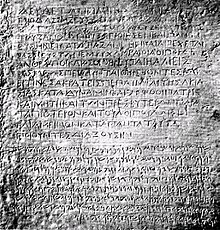
Chandragupta's grandsonAshokaconverted to the Buddhist faith and became a great proselytizer in the line of the traditional Pali canon ofTheravadaBuddhism, directing his efforts towards the Indo-Iranic and the Hellenistic worlds from around 250 BC. According to theEdicts of Ashoka,set in stone, some of them written in Greek, he sent Buddhist emissaries to the Greek lands in Asia and as far as the Mediterranean. The edicts name each of the rulers of theHellenisticworld at the time.
The conquest byDharmahas been won here, on the borders, and even six hundredyojanas(4,000 miles) away, where the Greek kingAntiochosrules, beyond there where the four kings namedPtolemy,Antigonos,MagasandAlexanderrule, likewise in the south among theCholas,thePandyas,and as far asTamraparni.(Edicts of Ashoka,13th Rock Edict, S. Dhammika).
Some of the Greek populations that had remained in northwestern India apparently converted to Buddhism:
Here in the king's domain among the Greeks, theKambojas,the Nabhakas, the Nabhapamkits, the Bhojas, the Pitinikas, theAndhrasand the Palidas, everywhere people are following Beloved-of-the-Gods' instructions inDharma.(Edicts of Ashoka,13th Rock Edict, S. Dhammika).
Furthermore, according toPalisources, some of Ashoka's emissaries were Greek Buddhist monks, indicating close religious exchanges between the two cultures:
When thethera(elder) Moggaliputta, the illuminator of the religion of the Conqueror (Ashoka), had brought the (third) council to an end... he sent forth theras, one here and one there:... and to Aparantaka (the "Western countries" corresponding toGujaratandSindh) he sent the Greek (Yona) namedDhammarakkhita... and thetheraMaharakkhita he sent into the country of the Yona. (Mahavamsa,XII).
Greco-Bactrians probably received these Buddhist emissaries (at least Maharakkhita, lit. "The Great Saved One", who was "sent to the country of the Yona" ) and somehow tolerated the Buddhist faith, although little proof remains. In the 2nd century AD, the Christian dogmatistClement of Alexandriarecognized the existence of BuddhistSramanasamong the Bactrians ( "Bactrians" meaning "Oriental Greeks" in that period), and even their influence on Greek thought:
Thus philosophy, a thing of the highest utility, flourished in antiquity among the barbarians, shedding its light over the nations. And afterwards it came to Greece. First in its ranks were the prophets of theEgyptians;and theChaldeansamong theAssyrians;[62]and theDruidsamong theGauls;and theSramanasamong theBactrians( "Σαρμαναίοι Βάκτρων"); and the philosophers of theCelts;and theMagiof thePersians,who foretold the Saviour's birth, and came into the land ofJudeaguided by a star. The Indiangymnosophistsare also in the number, and the other barbarian philosophers. And of these there are two classes, some of them calledSramanas( "Σαρμάναι"), and othersBrahmins( "Βραφμαναι").[63]
Influence on Indian art during the 3rd century BC[edit]

The Greco-Bactrian city ofAi-Khanoum,being located at the doorstep of India, interacting with the Indian subcontinent, and having a rich Hellenistic culture, was in a unique position to influence Indian culture as well. It is considered that Ai-Khanoum may have been one of the primary actors in transmitting Western artistic influence to India, for example in the creation of thePillars of Ashokaor the manufacture of the quasi-IonicPataliputra capital,all of which were posterior to the establishment of Ai-Khanoum.[64]
The scope of adoption goes from designs such as thebead and reelpattern, the centralflame palmettedesign and a variety of othermoldings,to the lifelike rendering of animal sculpture and the design and function of the Ionicanta capitalin the palace ofPataliputra.[65]
First visual representations of Indian deities[edit]


One of the last Greco-Bactrian kings,Agathocles of Bactria(ruled 190–180 BC), issued remarkable Indian-standard square coins bearing the first known representations of Indian deities, which have been variously interpreted asVishnu,Shiva,Vasudeva,BuddhaorBalarama.Altogether, six such Indian-standard silverdrachmasin the name of Agathocles were discovered at Ai-Khanoum in 1970.[66][67][68]These coins seem to be the first known representations ofVedic deitieson coins, and they display earlyAvatarsofVishnu:Balarama-Sankarshanawith attributes consisting of theGadamace and theplow,andVasudeva-Krishnawith theVishnuattributes of theShankha(a pear-shaped case or conch) and theSudarshana Chakrawheel.[67]Some other coins by Agathocles are also thought to represent theBuddhistlion and the Indian goddessLakshmi,consort ofVishnu.[68]The Indian coinage of Agathocles is few but spectacular. These coins at least demonstrate the readiness of Greek kings to represent deities of foreign origin. The dedication of a Greek envoy to the cult ofGarudaat theHeliodorus pillarinBesnagarcould also be indicative of some level of religioussyncretism.
List of Greco-Bactrian Kings[edit]
The below table lists the known Greek rulers of Bactria, along with their dates and titles or epithets.
| Reign (approx.) | King | Title |
|---|---|---|
| 255–239 BCE | Diodotus I | Soter |
| 239–223 BCE | Diodotus II | Theos |
| 230–200 BCE | Euthydemus I | Theos |
| 200–180 BCE | Demetrius I | Anicetus |
| 200–180 BCE | Pantaleon | Soter |
| 190-180 BCE | Agathocles | Dikaios |
| 185-180 BCE | Euthydemus II | — |
| 180-170 BCE | Antimachus I | Theos |
| 180-160 BCE | Apollodotus I | Soter |
| 175–160 BCE | Demetrius II | — |
| 171–145 BCE | Eucratides I | Megas |
| 145–140 BCE | Eucratides II | Soter |
| 145–140 BCE | Plato | Epiphanes |
| 140–130 BCE | Heliocles I | Dikaios |
It must be noted that dates that overlap show that multiple kings ruled at the same time, but in different regions whose exact details are not known very well. For example Apollodotus I likely ruled areas south of Bactria and the Indian subcontinent while Antimachus I ruled in Bactria.[69]Eucratides II and Plato would have each ruled smaller parts of southern Bactria.
See also[edit]
Notes[edit]
- ^Some cities were still controlled by Greek kings such asHermaeus Soter(90–70 BC) in what is todayKabul.
- ^Mentioned in "Hellenism in ancient India", Banerjee, p 140,[full citation needed]to be taken carefully since Orosius is often rather unreliable in his accounts.
- ^"They are a nation of nomads, moving from place to place with their herds, and their customs are like those of the Xiongnu. They have some 100,000 or 200,000 archer warriors... The Yuezhi originally lived in the area between theQilianor Heavenly mountains andDunhuang,but after they were defeated by the Xiongnu they moved far away to the west, beyondDayuan,where they attacked and conquered the people ofDaxia(Bactria) and set up the court of their king on the northern bank of the Gui (Oxus) river ".[35]
- ^On the image of the Greek kneeling warrior: "A bronze figurine of a kneeling warrior, not Greek work, but wearing a version of the Greek Phrygian helmet... From a burial, said to be of the 4th century BC, just north of the Tien Shan range".[53]
- ^Notice of the British Museum on the Zhou vase (2005, attached image): "Red earthenware bowl, decorated with a slip and inlaid with glass paste. Eastern Zhou period, 4th–3rd century BC. This bowl may have intended to copy a possibly foreign vessel in bronze or even silver. Glass has been both imported from the Near East and produced domestically by the Zhou States since the 5th century BC."
- ^"The things which China received from the Graeco-Iranian world-the pomegranate and other" Chang-Kien "plants, the heavy equipment of the cataphract, the traces of Greeks influence on Han art (such as) the famous white bronze mirror of the Han period with Graeco-Bactrian designs... in the Victoria and Albert Museum"[54]Its popularity at the end of the Eastern Zhou period may have been due to foreign influence. "[citation needed]
References[edit]
- ^Taagepera, Rein (1979). "Size and Duration of Empires: Growth-Decline Curves, 600 B.C. to 600 A.D.".Social Science History.3(3–4): 132.doi:10.2307/1170959.JSTOR1170959.
- ^The Ancient Greco-Bactrian kingdom and Hellenistic AfghanistanBrewminate,Archived2021-09-24 at theWayback Machine-Matthew A. McIntosh
- ^Cribb, Joe (2005)."The Greek Kingdom of Bactria, its coinage and its collapse".Afghanistan Ancien Carrefour Entre Lʼest et Lʼouest:1 – viaAcademia.
- ^Mairs, Rachel (2016)."Bactrian or Graeco-Bactrian Kingdom".The Encyclopedia of Empire:1–4.
- ^Lucas, Christopoulos. Dionysian Rituals and the Golden Zeus of China. Sino-Platonic Papers 326.
- ^Strabo, Geography 11.11.1
- ^Doumanis, Nicholas. (16 Dec 2009)A History of Greece[permanent dead link]Palgrave MacmillanISBN978-1137013675p 64
- ^Baumer, Christoph.(11 Dec 2012)The History of Central Asia: The Age of the Steppe WarriorsArchived2022-11-19 at theWayback MachineVol.1I.B. Tauris,ISBN978-1780760605p 289
- ^Kaushik Roy. ( 28 July 2015)Military Manpower, Armies and Warfare in South AsiaArchived2022-11-19 at theWayback Machine.Routledge,ISBN978-1317321279
- ^Herodotus, 4.200–204
- ^Strabo, 11.11.4
- ^"Afghanistan: Graeco-Bactrian Kingdom".2020-12-23. Archived fromthe originalon 2020-12-23.Retrieved2023-10-06.
- ^J. D. Lerner (1999),The Impact of Seleucid Decline on the Eastern Iranian Plateau: The foundations of Arsacid Parthia and Graeco-Bactria,Stuttgart
- ^F. L. Holt(1999),Thundering Zeus,Berkeley.
- ^"Justin XLI, paragraph 4".Archivedfrom the original on 2019-11-10.Retrieved2006-01-14.
- ^"Justin XLI, paragraph 1".Archivedfrom the original on 2019-11-10.Retrieved2006-01-14.
- ^Possibly present dayQarshi;Encyclopaedia Metropolitana: Or Universal Dictionary of Knowledge, Volume 23, ed. by Edward Smedley, Hugh James Rose, Henry John Rose, 1923, p. 260: "Eucratidia, named from its ruler, (Strabo, xi. p. 516.) was, according to Ptolemy, 2° North and 1° West of Bactra." As these coordinates are relative to, and close to,Bactra,it is reasonable to disregard the imprecision in Ptolemy's coordinates and accept them without adjustment. If the coordinates for Bactra are taken to be36°45′N66°55′E/ 36.750°N 66.917°E,then the coordinates38°45′N65°55′E/ 38.750°N 65.917°Ecan be seen to be close to the modern day city ofQarshi.
- ^ab"Strabo XI.XI.I".Archivedfrom the original on 2008-04-19.Retrieved2021-02-20.
- ^"Justin XLI".Archivedfrom the original on 2019-11-10.Retrieved2006-01-14.
- ^"Euthydemus".Encyclopaedia Iranica.
- ^ab"Polybius 11.34".Archivedfrom the original on 2008-04-20.Retrieved2021-02-20.
- ^ab"Strabo 11.11.2".Archivedfrom the original on 2008-04-19.Retrieved2021-02-20.
- ^ab"Polybius 10.49, Battle of the Arius".Archivedfrom the original on 2008-03-19.Retrieved2021-02-20.
- ^"Polybius 11.34 Siege of Bactra".Archivedfrom the original on 2008-04-20.Retrieved2021-02-20.
- ^abShane WallaceGreek Culture in Afghanistan and India: Old Evidence and New DiscoveriesArchived2020-01-12 at theWayback Machinep.206
- ^Osmund Bopearachchi,Some Observations on the Chronology of the Early KushansArchived2021-03-08 at theWayback Machine,p.48
- ^Shane WallaceGreek Culture in Afghanistan and India: Old Evidence and New DiscoveriesArchived2020-01-12 at theWayback Machinep. 211
- ^"Supplementum Epigraphicum Graecum: 54.1569".Archivedfrom the original on 2021-02-07.Retrieved2019-11-15.
- ^Cary, M. (1963).A History of the Greek World Form 323 to 146 B.C.p. 75.
- ^"The COININDIA Coin Galleries: Greek: Eucratides I (Eukratides I)".coinindia.Retrieved2024-06-19.
- ^abc"Justin XLI,6".Archivedfrom the original on 2019-11-10.Retrieved2006-01-14.
- ^"Justin XXXVI, 1,1".Archivedfrom the original on 2005-11-20.Retrieved2006-02-11.
- ^McLaughlin, Raoul (2016).The Roman Empire and the Silk Routes: the Ancient World Economy and the Empires of Parthia, Central Asia and Han China.Havertown: Pen and Sword.ISBN978-1-4738-8982-8.OCLC961065049.
- ^"Parthians and Sassanid Persians", Peter Wilcox, p 15[full citation needed]
- ^Sima Qian.Records of the Great Historian.Translated by Watson, Burton. p. 234.
- ^"Strabo 11-8-1 on the nomadic invasions of Bactria".Archivedfrom the original on 2022-11-19.Retrieved2021-02-20.
- ^Narain 1990,p. 153.
- ^Beckwith 2009,p. 5, footnote 16, as well as pp. 380–383 in appendix B, but also seeHitch 2010,p. 655: "He equates the Tokharians with the Yuezhi, and the Wusun with the Asvins, as if these are established facts, and refers to his arguments in appendix B. But these identifications remain controversial, rather than established, for most scholars."
- ^"CNG: Feature Auction CNG 99. BAKTRIA, Greco-Baktrian Kingdom. Uncertain. Early-mid 1st century BC(?). AR Obol (11mm, 0.49 g, 1h)".cngcoins.Retrieved2024-06-19.
- ^abNikonorov, Valerii; The Armies of Bactria 700 B.C. – 450 A.D
- ^Willy, Clarysse & Thompson, Dorothy. (2007). Two greek texts on skin from hellenistic bactria. 159. 273-279.
- ^"The COININDIA Coin Galleries: Greek: Antimachus I (Antimachos I)".coinindia.Retrieved2024-06-20.
- ^Nikonorov, Valerii; The Armies of Bactria 700 B.C. – 450 A.D, page 39.
- ^Willy, Clarysse & Thompson, Dorothy. (2007). Two greek texts on skin from hellenistic bactria. 159. 273-279.
- ^abcdLitvinskii, B.A.; Pichikian, I.R. (1994)."The Hellenistic architecture and art of the Temple of the Oxus"(PDF).Bulletin of the Asia Institute.8:47–66.ISSN0890-4464.JSTOR24048765.
- ^Metalwork from the Hellenized East: catalogue of the collections(PDF).Malibu, CA: J. Paul Getty Museum. 1993. p. 9.ISBN0-89236-218-9.
- ^Boardman, John(2015).The Greeks in Asia.London: Thames & Hudson. p. 200.
The other has a more informative scene of a war elephant [53], with mahout and a turreted howdah bearing two warriors, one wearing a Macedonian helmet, suggesting a more southerly origin for the type: very Indian, at first sight, but it seems that adding a mini-fortress to an elephant's back was a Greek invention, so this is a successor to those elephants with which Indian kings used to bribe westerners. The cloth below the howdah is decorated with a Greek sea monster (ketos).
- ^Color image, courtesy of theHermitage Museuminvan Oppen de Ruiter (2019)."Monsters of Military Might: Elephants in Hellenistic History and Art".Arts.8(4): 160.doi:10.3390/arts8040160.
- ^Holt 1989,p. 43.
- ^Bopearachchi, Osmund (1998)."A faience head of a Graeco-Bactrian king from Ai Khanum".Bulletin of the Asia Institute.12:27.ISSN0890-4464.JSTOR24049090.
- ^Wood, Rachel (2011)."Cultural convergence in Bactria: the votives from the Temple of the Oxus at Takht-i Sangin, in" From Pella to Gandhara "".In A. Kouremenos, S. Chandrasekaran & R. Rossi ed. 'From Pella to Gandhara: Hybridization and Identity in the Art and Architecture of the Hellenistic East'.Oxford: Archaeopress: 141–151.
- ^Betts, Alison; Vicziany, Marika; Jia, Peter Weiming; Castro, Angelo Andrea Di (19 December 2019).The Cultures of Ancient Xin gian g, Western China: Crossroads of the Silk Roads.Archaeopress Publishing Ltd. p. 103.ISBN978-1-78969-407-9.
- ^Ürümqi Xin gian g Museum. (Boardman "The diffusion of Classical Art in Antiquity" )[full citation needed]
- ^Tarn,The Greeks in Bactria and India,pp. 363–364[full citation needed]
- ^"BBC Western contact with China began long before Marco Polo, experts say".BBC News.12 October 2016.Archivedfrom the original on 2020-03-16.Retrieved2018-06-21.
- ^"The mausoleum of China's first emperor partners with the BBC and National Geographic Channel to reveal groundbreaking evidence that China was in contact with the west during the reign of the first emperor"(Press release). 12 October 2016.Archivedfrom the original on 2020-02-16.Retrieved2016-10-12.
- ^"Why China's terracotta warriors are stirring controversy".Live Science.20 November 2016.
- ^"Copper-Nickel coinage in Greco-Bactria".Archived fromthe originalon 2005-03-06.Retrieved2004-10-30.
- ^Ancient Chinese weaponsArchived2005-03-07 at theWayback MachineA halberd of copper-nickel alloy, from the Warring States Period.Archived2012-05-27 atarchive.today
- ^A.A. Moss pp 317–318Numismatic Chronicle1950
- ^"C.Michael Hogan,Silk Road, North China,Megalithic Portal, ed. A. Burnham ".Archivedfrom the original on 2013-10-02.Retrieved2008-02-20.
- ^Viglas, Katelis (2016)."Chaldean and Neo-Platonic Theology".Philosophia e-Journal of Philosophy and Culture(14): 171–189.
The name "Chaldeans" refers generally to theChaldeanpeople who lived in the land ofBabylonia,and especially to the Chaldean "magi" of Babylon.... The "Chaldeans" were the guardians of the sacred science: The astrological knowledge and the divination mixed with religion and magic. They were considered the last representatives of the Babylonian sages.... In Classical Antiquity, the name "Chaldeans" primarily stood for the priests of the Babylonian temples. In Hellenistic times, the term "Chaldeos" was synonymous with the words "mathematician" and "astrologer".... TheNeo-Platonistsconnected theChaldean Oracleswith the ancient Chaldeans, obtaining a prestige coming from the East and legitimizing their existence as bearers and successors of an ancient tradition.
- ^"Clement of Alexandria" The Stromata, or Miscellanies "Book I, Chapter XV".Archivedfrom the original on 2010-05-10.Retrieved2005-12-18.
- ^"John Boardman," The Origins of Indian Stone Architecture ", p.15".JSTOR24049089.Archivedfrom the original on 2017-02-02.Retrieved2017-08-31.
- ^"John Boardman," The Origins of Indian Stone Architecture ", p.13-22".JSTOR24049089.Archivedfrom the original on 2017-02-02.Retrieved2017-08-31.
- ^Frank Lee Holt, (1988),Alexander the Great and Bactria: The formation of a Greek frontier in central Asia,Brill Archive p. 2[1]
- ^abIconography of Balarāma, Nilakanth Purushottam Joshi, Abhinav Publications, 1979, p.22[2]
- ^abPeter Thonemann, (2016),The Hellenistic World: Using coins as sources,Cambridge University Press, p. 101[3]
- ^"The COININDIA Coin Galleries: Greek: Apollodotus I (Apollodotos I)".coinindia.Retrieved2024-06-29.
Sources[edit]
- Beckwith, Christopher I.(2009).Empires of the Silk Road: A History of Central Eurasia from the Bronze Age to the Present.Princeton University Press.ISBN978-1-4008-2994-1.
- Boardman, John (1994).The Diffusion of Classical Art in Antiquity.Princeton University Press.ISBN0-691-03680-2.
- Boardman, John, Jasper Griffin, and Oswyn Murray (2001).The Oxford Illustrated History of Greece and the Hellenistic World.Oxford University Press.ISBN978-0-19-285438-4.
- Bopearachchi,Osmund (1991).Monnaies Gréco-Bactriennes et Indo-Grecques, Catalogue Raisonné.Bibliothèque Nationalede France,ISBN2-7177-1825-7.
- Bopearachchi, Osmund and Christine Sachs (2003).De l'Indus à l'Oxus, Archéologie de l'Asie Centrale: catalogue de l'exposition.ISBN2-9516679-2-2.
- Hitch, Doug (2010)."Empires of the Silk Road: A History of Central Eurasia from the Bronze Age to the Present"(PDF).Journal of the American Oriental Society.130(4): 654–658.Bibcode:2010IJNAr..39..207P.doi:10.1111/j.1095-9270.2009.00260_11.x.Archived fromthe original(PDF)on 2013-12-26.Retrieved2015-01-02.
- Holt, F. L. (1989).Alexander the Great and Bactria: The Formation of a Greek Frontier in Central Asia: 2nd Edition.Leiden: Brill.ISBN90-04-08612-9.
- McEvilley, Thomas (2002).The Shape of Ancient Thought. Comparative studies in Greek and Indian Philosophies.Allworth Press and the School of Visual Arts.ISBN1-58115-203-5
- Narain, A. K.(1990). "Indo-Europeans in Central Asia". InSinor, Denis(ed.).The Cambridge History of Early Inner Asia.Vol. 1. Cambridge University Press. pp. 151–177.doi:10.1017/CHOL9780521243049.007.ISBN978-1-139-05489-8.
- Puri, B. N. (2000).Buddhism in Central Asia.Motilal Banarsidass, Delhi.ISBN81-208-0372-8.
- Tarn, W. W. (1966)The Greeks in Bactria and India.2nd Edition. Cambridge University Press.
- Watson, Burton, trans. (1993).Records of the Great Historian. Han dynasty II,bySima Qian.Columbia University Press.ISBN0-231-08167-7.
External links[edit]
- Greco-Bactrian Kingdom
- Former monarchies of South Asia
- Former monarchies of Central Asia
- Lists of monarchs
- Former countries in Central Asia
- Former countries in South Asia
- Hellenistic states
- States and territories established in the 3rd century BC
- 256 BC
- 250s BC establishments
- 3rd-century BC establishments
- States and territories disestablished in the 2nd century BC
- 125 BC
- 2nd-century BC disestablishments
- Former kingdoms




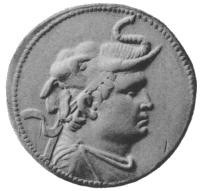





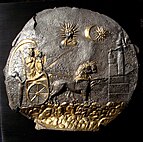
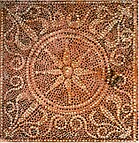
![Bactrian phalera with military elephant carrying a howdah fortress manned by a soldier wearing a Macedonian helmet. 2nd century BCE, Hermitage Museum.[46][47][48]](https://upload.wikimedia.org/wikipedia/commons/thumb/1/1c/Bactrian_phalera_%28front%29_with_military_elephants%2C_2nd_century_BCE%2C_Hermitage_Museum%2C_Saint_Peterburg.jpg/143px-Bactrian_phalera_%28front%29_with_military_elephants%2C_2nd_century_BCE%2C_Hermitage_Museum%2C_Saint_Peterburg.jpg)

![Ionic pillar, cella of the Temple of the Oxus, Takht-i Sangin, late 4th - early 3rd century BCE.[45]](https://upload.wikimedia.org/wikipedia/commons/thumb/0/03/Ionic_pillar%2C_cella_of_the_Temple_of_the_Oxus%2C_Takht-i_Sangin%2C_late_4th_-_early_3rd_century_BCE.jpg/90px-Ionic_pillar%2C_cella_of_the_Temple_of_the_Oxus%2C_Takht-i_Sangin%2C_late_4th_-_early_3rd_century_BCE.jpg)
![Head of a Greco-Bactrian ruler with diadem, Temple of the Oxus, Takht-i Sangin, 3rd–2nd century BCE. This could also be a portrait of Seleucus I.[50]](https://upload.wikimedia.org/wikipedia/commons/thumb/0/0d/Head_of_a_Greco-Bactrian_ruler%2C_Temple_of_the_Oxus%2C_Takht-i-Sangin%2C_3rd-2nd_century_BCE.jpg/100px-Head_of_a_Greco-Bactrian_ruler%2C_Temple_of_the_Oxus%2C_Takht-i-Sangin%2C_3rd-2nd_century_BCE.jpg)
![Hellenistic silenus Marsyas from Takhti Sangin, with dedication in Greek to the god of the Oxus, by "Atrosokes" (a Bactrian name). Temple of the Oxus, Takht-i Sangin, 200–150 BCE. Tajikistan National Museum.[45][51]](https://upload.wikimedia.org/wikipedia/commons/thumb/5/51/Altar_to_God_Oxus%2C_with_Marsias_playing_the_aolos%2C_Temple_of_the_Oxus%2C_Takht-i_Sangin%2C_dated_2nd_century_BCE.jpg/90px-Altar_to_God_Oxus%2C_with_Marsias_playing_the_aolos%2C_Temple_of_the_Oxus%2C_Takht-i_Sangin%2C_dated_2nd_century_BCE.jpg)
![Alexander-Heracles head, Takht-i Sangin, Temple of the Oxus, 3rd century BCE.[45]](https://upload.wikimedia.org/wikipedia/commons/thumb/9/93/Alexander-Herakles_head%2C_Takht-i_Sangin%2C_Temple_of_the_Oxus%2C_3rd_century_BCE.jpg/101px-Alexander-Herakles_head%2C_Takht-i_Sangin%2C_Temple_of_the_Oxus%2C_3rd_century_BCE.jpg)


